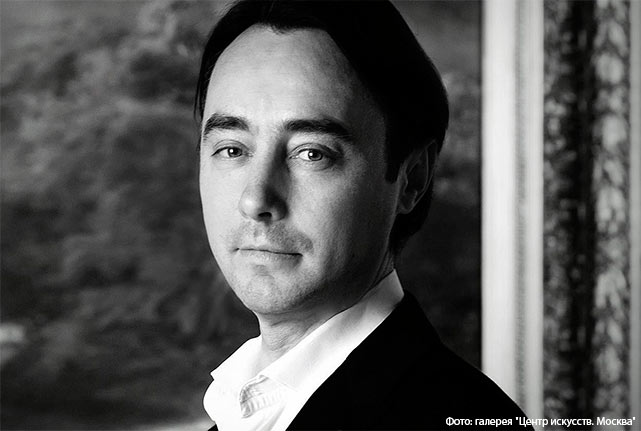One day, when I was passing by the Cathedral of Christ the Saviour, I saw an advertising stand displaying exhibitions held there. “Such place cannot host a bad event”, – I thought. Moreover, the poster was illustrating the famous Russian artists M. Nesterov, I. Aivazovsky…
What I saw differed from expectations. It was not like other exhibitions. It was a new artistic expression that combined the latest technological achievements with the world-class works of art. And the public understands it as the attendance of the exhibition has been growing steadily.
We were introduced to the author of the idea and curator Andrian Melnikov. The interview that we share with the readers uncoveres interesting features and prospects of the project “Art treasures of Russia”.
EV: Andrian, the exhibition is held in the Cathedral of Christ the Saviour. I was expecting more orthodox subjects. Please tell me, how the project is related with with Orthodoxy?
Andrian Melnikov: It is good when culture and spirituality are coming together, complementing each other. If spirituality is devoid of culture, it is possible to go in the wrong direction. A pride may surge up or other temptation occur, and the result will not be spirituality, but degradation. We are often visited by priests from the Cathedral, the priests bring their floc and friends. An extensive exchange between spirituality and culture happens this way.
EV: If you outline the project, what is it now? It includes musical evenings, lectures, and… what else?
Andrian Melnikov: First of all, it is painting itself. It often happens that, the works are much better here than those in the public and other private museums. We can afford to “skim the cream” from different collections. Even Alexander III and the Royal family, Tretyakov could not afford to buy some things, as they were unaffordable. They were bought by merchants and foreigners, inherited, hidden during the revolution and the war. Many of the paintings were cleaned from dust and soot by us. All of this was washed with alkali-free soap, varnished, and normalized. So, we have a real treasure here. That’s why we called the exhibition “Art treasures of Russia”.
The project is an exhibition ground, where the exhibitions of the Russian art and Western European painting of XIV-XIX centuries take place. The project is designed primarily for specialists, it presents hitherto unseen masterpieces, paintings that supposedly were lost. Many experts and researchers in the field of painting come here to study them. But non-specialists are also inspired by the exhibition.
EV: I would like to ask you to focus on the main points of the exposition.
Andrian Melnikov: At the entrance we show the work of the installment “To the glory of the Fatherland”, dedicated to 1812, and the portrait of Alexander I, because the Cathedral of Christ the Savior was built at his dictation in honor of the victory. This portrait is from the personal collection of Alexander II, it was at Tsarskoe Selo, and then it was sold or stolen by the bolsheviks and taken abroad, where it was a part of a private collection 5-7 years ago.
The exhibition also shows historical painting, the installments of Mikhail Nesterov, Ivan Aivazovsky, an installment of lyrical landscape, the icons in the art of enamel, and all this in the framework of the project “Art treasures of Russia”.
EV: Is there any strict time frame for this exhibition or it is flexible?
Andrian Melnikov: There is no strict time frame. We have the exhibitions with a designated end time, but we usually continue it, having made some changes in the exhibition. For example, we had a hall of Aivazovsky from the very beginning. Now, a part of this exhibition moved to the Tretyakov gallery, the other part – in the Russian Museum, and another exhibition will be held there, and the other pictures took up the free space. We have an exposure by Aivazovsky unknown to the general public, with paintings from private museums, in contrast to the exhibition at the gallery on Krymsky Val, where the exhibits are taken predominantly from the state museums.
In the hall of icons we have an icon with relics of St. Nicholas that presumably had been given to Nicholas II. Every icon that is represented here is not only a fine painting, but it is also a riza of high-quality enamel. The rizas of our iconic exposure were performed by the best masters, who were the suppliers of the Imperial court and who worked for Faberge: Tarabrov, Ovchinnikov and Khlebnikov.
Here we have the first work of V. Vasnetsov, the works of suppliers of the Imperial court, Chirikov and Guryanov. The Icons, which belonged to Boris Godunov, A. Pushkin, the Golitsyns. Now, they are the parts of private collections. Altogether we have 3 halls of icons.
Everything has its history, each piece is unique. The pictures of A. Savrasov, which was written specially for the personal collection of Tretyakov. Tretyakov put up some pictures in the gallery, and some of them he hung in his country house. The Russia’s only Moscow by V. Vereshchagin, which is known for its Asian works only. He took to New York the whole series for a solo exhibition, and sold it to fraudsters; he did not receive the money.
We have also wonderful furniture here. A cabinet that belonged to Nicholas I, who gave it to the daughter of Queen Victoria for the wedding. The cabinet has a genealogy: where it was made, where it was moved. There is furniture from the Winter Palace and the Stroganov school.
EV: I would like to ask you as expert, what is a modern collector, what’s hidden behind his passion for collecting? And why does he bring it all here?
Andrian Melnikov: The collectors collect because they have love for, inclination towards art and corresponding education. Naturally, they learn what to collect, and they understand how much it costs.
Why do they bring it to us? Personally, I have been for 18 years in this business, and when you are constantly moving around the world, participate in exhibitions, contact with people who turn out to be collectors, investors, colleagues, every day you build your database, your personal Fund. And if you have a normal, healthy reputation, you share information, your collection for exhibitions, it reveals the moment of trust. And if you start a project, you also have the trust.
On this project. First, we hung the paintings here, and I invited my friends to the gallery to see what can happen, if they give their pieces of art. And, of course, I said a few magic words, which they understood and, the very next day, they brought their paintings. Then we hung them and began to take pictures, made up a large catalog and, of course, the social networks started to talk about it…
EV: Is there an understanding in this society that cultural space of Russia is our common goal?
Andrian Melnikov: Yes, of course. Viktor Vekselberg opened a Museum of Faberge, D. Iakobachvili opens the Museum of decorative and applied arts “Sobranie”, B. Mintz opened the Museum of Russian Impressionism, Ananiev brothers opened the Institute of Russian realist art, the Museum-exhibition complex. Many want to build their own Museum from their collections. Perhaps, our experience will help someone. We showed how the space works, how to keep the audience interested, and how it is important your own collection to show the public.
In the West, many of my friends are also thinking about a museum. Someone wants to make a museum of Italian art, others want a museum of Dutch art, and I think that it happens not only in Russia, it is a global trend.
EV: The gallery is beautiful. I would even call it a “a palace type of hanging” but not a museum one. You walk around and feel the comfort and the possibility of contemplation…
Andrian Melnikov: Hanging is our forte. In the times when these pictures were painted, salons were popular and we wanted to give the visitor the feeling that he goes out there and mingles through the very genre of the hanging. Operas, ballets, and also the carefully selected events of leasing companies take place at this location.
And, by the way, it is the only place where people don’t drink alcohol on opening days.
EV: Here you feel like an honored guest, not just a visitor.
Andrian Melnikov: The elderly women are those who especially appreciate it: we have a social day on Tuesdays. About 74’000 people have passed through our gallery for free. This category is very grateful and is a great advertising channel, they are all very active in social networks. 75% of visitors come to us via a female radio. And people sometimes come for the thirtieth or fortieth time.
In the first two months the entrance was free, but due to a high traffic, it turned out to be difficult in the terms of financing, as we had to pay out of pocket, no one helped us. The fees, rent, security, communication, parking, – we’ve overrated our strength. About a month ago, a need occurred to find sponsors. The government helped us with banners and provided the visits of the elite audience, but the need for funding was not removed.
If we could find people who would do serious investment, we could propose other projects that we already have, they are formed. We are going to promote them, and we wish they had the format of a public-private partnership. In these eight months, we worked with the city authorities, the Department of culture represented by A. Kirovskiy, he asked us to make a hologram for the cultural forum in the Manezh. We also created holograms for the Department of tourism. The hologram is our improvement and we are proud of it; we are involved a defense plant in this activity.
EV: I saw preschoolers at the musical performance, which was sounding quite complex. They sat and politely listened to the Viennese classics, then ran around the show and watched the paintings with interest. You attract a younger audience, and it’s supposed to please you, according to the concept?
Andrian Melnikov: Of course, it is important for us, because the children get knowledge of culture, ethics, spirituality.
Children feel the art and are very careful with painting, they do not touch it with fingers. They watch pictures from distance and respect the space of the picture.
There is a program you can download on your iPad or iPhone. You can point the device at a picture and receive information and also send any picture to your device. And at home, you also can point the gadget at the screen and animate the picture.
We created the quests, we had the Christmas and the new year’s quests, where the children searched for the treasure by guessing the plot of a picture. The picture asks a riddle about another painting, the child guesses 10 paintings and gets a prize at the reception. It works.
EV: Do the foreigners get interested in the project?
Andrian Melnikov: Yes, when they get here, they immediately dip into this space. It’s very interesting. Many of them don’t know anything about the Russian art, but here they begin to understand what it is. They start watching the works of artists little known even to the Russian audience… the Japanese like the sceneries for some reason. We had the former Minister of Finance of Japan, he watched Shishkin and found that the landscape is from his childhood. The stars also visit us, for example Steven Seagal.
The guides visited us and said they would enter this space into a must visit list for the tourist groups. Next time they will visit us, when they show the Cathedral of Christ the Saviour, the Patriarch’s ecclesiastical art museum and the Arts Centre. Moscow is a complex, and now we tie it all to the Cathedral as a single space. We’re making one entrance and will achieve a cyclical view, people will walk in a circle.





